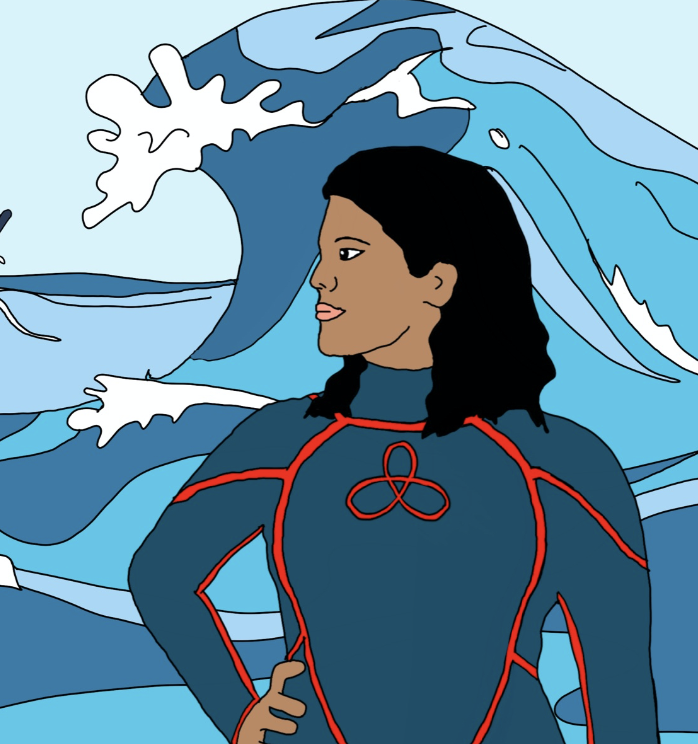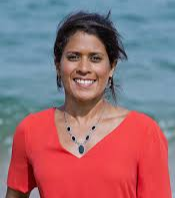
Get to Know
ASHA DE VOS
In this fact-file find out why we turned Asha into a superhero.
WHO IS ASHA DE VOS?
Full Name: Asha de Vos
Occupation: Marine Biologist
Born: 1979
Nationality: Sri Lankan
Dr. Asha de Vos is a marine biologist and one of the world’s leading voices for ocean conservation. She is best known for founding Oceanswell and the Blue Whale Project, the first long-term research initiative dedicated to studying blue whales in the Northern Indian Ocean.
Her work uncovered a previously undocumented, non-migratory population of blue whales off the coast of Sri Lanka — changing what the scientific community thought it knew about these giants of the sea.
A gifted communicator and passionate educator, Asha is a Senior TED Fellow, National Geographic Explorer, and an advocate for inclusive, accessible science. Her mission is to inspire a new generation of ocean ambassadors.
Occupation: Marine Biologist
Born: 1979
Nationality: Sri Lankan
Dr. Asha de Vos is a marine biologist and one of the world’s leading voices for ocean conservation. She is best known for founding Oceanswell and the Blue Whale Project, the first long-term research initiative dedicated to studying blue whales in the Northern Indian Ocean.
Her work uncovered a previously undocumented, non-migratory population of blue whales off the coast of Sri Lanka — changing what the scientific community thought it knew about these giants of the sea.
A gifted communicator and passionate educator, Asha is a Senior TED Fellow, National Geographic Explorer, and an advocate for inclusive, accessible science. Her mission is to inspire a new generation of ocean ambassadors.

In The Remarkablz Universe, Asha has the ability to use sound waves and echolocation to sense her surroundings, communicate with marine animals, and locate objects with extraordinary precision. Her powers awakened during a childhood voyage across the Indian Ocean. When the ship her family was traveling on capsized in a sudden storm, Asha found herself stranded in open water. Terrified she heard something strange — a clicking language beneath the waves. To her surprise, she could understand it. Asha had formed a link with nearby whales. Working together, Asha and the whales navigated the vast ocean. Using nothing but the echoes of sound bouncing across the water, she located a passing cargo ship. Her quick thinking and newfound gift saved her family and the other survivors.
Superhero Backstory
Echolocation: Asha studies whales. Whales use echolocation for navigating.
The box to Asha's right has a number of hidden secrets inside.
- The puppet was used by Asha during her 2013 TED-Ed lesson
- She was nominated as 2016 Emerging Explorer by National Geographic
- In a 2017 interview Asha talks about digging potatoes in Scotland to pay for her studies.
- The logo on Asha's chest is the the logo of the Blue Whale Project. Asha founded the Blue Whale Project in 2008, which studies blue whales in the northern Indian Ocean.
Superpower
Asha founded the Blue Whale Project in 2008, which studies blue whales in the northern Indian Ocean.
You can find Asha in Perth. Why? Because populations of Sri Lankan blue whales can also be found in Perth.
Location
SideKick
Asha's side-kick is marine biologist Sylvia Earle. Sylvia looks at marine ecosystems with a focus on conservation.
Ship traffic crossing the Indian Ocean results in ship strikes which injures and kills many whales
Weakness
Each drawing we create has one or more hidden treasure(s) about our superheroes' life experiences, depictions in art, jobs or discoveries. Did you find the ones hidden in this drawing?
Discovery

We have packed a lot into our Top Quarkz playing cards - from amazing imagined superpowers to biographical information and hidden treasures.
EDUCATIONAL RESOURCES
How do you become a marine biologist?
Marine biology is the study of organisms and ecosystems in the ocean and other saltwater environments.
Video credit: BBC Earth
Video credit: BBC Earth
Why is whale poop important?
Whale poop gives marine biologists a picture of the life of whales: what they eat, how stressed they might be and it can even help to identify the whale species. Also, it is really important to the oceans' ecosystem. Find out why in this video from Oceanswells.
Why are whales so big?
Asha explains why whales are so big. You'll meet her puppet in this video.
Some
Facts
Facts
Do all blue whales speak the same language?
Do Indian Ocean blue whales migrate like other whales?
Not exactly! Blue whales around the world use different "dialects"—kind of like having different accents or languages. For example, blue whales in the Indian Ocean make sounds that are different from whales in the Pacific or Atlantic. These unique whale songs are how they talk to one another across long distances under the sea.
Nope! Most blue whales migrate long distances—swimming from cold polar waters in the summer to warmer tropical waters in the winter. But blue whales in the Indian Ocean are different. They’re non-migratory, which means they stay in warm tropical waters all year round. Scientists think they don’t need to travel far because they can find food and stay comfortable right where they are.
Unlike other blue whales that mostly eat krill (tiny shrimp-like animals found in cold waters), Indian Ocean blue whales eat actual shrimp and other small creatures found in warm seas. Their diet matches the environment they live in — and it’s one of the reasons they don’t need to migrate.
What do Indian Ocean blue whales eat?
How did scientists discover this?
Researchers like Dr. Asha de Vos studied these whales for years. By tracking their movements, recording their songs, and studying what they eat, they learned that this unique group of whales behaves very differently from others. Her work helped prove that not all blue whales follow the same rules.
Discover our free educational resources and activities
Don't miss out, sign up to our Newsletter!

DISCOVER MORE
A Remarkablz Product



